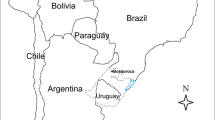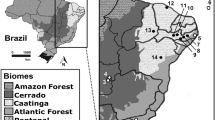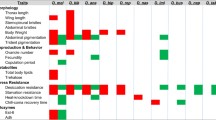Abstract
Environmental variables such as temperature and rainfall can directly affect the community structure of dipterans. Seasonal oscillations in the abundance of species of Drosophilidae reflect differences in how tolerant populations are to climatic conditions. Over a period of 14 months, we collected samples in two habitats in the Pampa biome in the municipality of São Luiz Gonzaga, state of Rio Grande do Sul, Brazil (28°24′28″S, 54°57′39″W). The influence of environmental variables on populations of Drosophilidae was evaluated for both collecting sites by using correlation analysis. The results suggested a negative correlation between the abundances of Drosophila cardinoides Dobzhansky & Pavan, Drosophila maculifrons Duda, Drosophila melanogaster Meigen, Drosophila nigricruria Patterson & Mainland, and Zygothrica vittimaculosa Burla with temperature, which is reflected in the distribution of these species within Brazil. Our findings are important for characterizing and preserving biodiversity in this almost-unknown biome in southern Brazil given the current climate change scenario.


Similar content being viewed by others
References
Bächli G, Vilela CR, Escher AS, Saura A (2004) The Drosophilidae (Diptera) of Fennoscandia and Denmark. Fauna Entomol Scand 39:1–362
Balanyá J, Huey RB, Gilchrist GW, Serra L (2009) The chromosomal polymorphism of Drosophila subobscura: a microevolutionary weapon to monitor global change. Heredity 103(5):364–367
Begon M, Harper JL, Townsend CR (1996) Ecology: individual, populations and communities. Blackwell, Cambridge, 1028 p
Bélo M, Filho JJO (1976) Espécies domésticas de Drosophila: influencias de fatores ambientais no numero de individuos capturados. Rev Bras Biol 36(4):903–909
Benado M, Brncic D (1994) An eight year phenological study of a local drosophilid community in Central Chile. Z Zool Syst Evolut-forsch 32:51–63
Bilenca DN, Miñarro FO (2004) Identificación de Áreas Valiosas de Pastizal (AVPs) em las Pampas y Campos de Argentina. Uruguay y sur de Brasil. Fundación Vida Silvestre, Buenos Aires, 323 p
Boldrini IL, Ferreira PMA, Andrade BO, Schneider AA, Setubal RB, Trevisan R & Freitas EM (2010) Bioma Pampa: diversidade florística e fisionômica. Ed. Pallotti. 64 p
Brisson JA, Wilder J, Hollocher H (2006) Phylogenetic analysis of the Cardini group of Drosophila with respect to changes in pigmentation. Evolution 60:1228–1241
Brncic D, Budnik M (1987) Some interactions of the colonizing species of Drosophila subobscura with local Drosophila fauna in Chile. Genet Iber 39:249–267
Cohet Y, Vouidibio J, David JR (1980) Thermal tolerance and geographic distribution: a comparison of cosmopolitan and tropical endemic Drosophila species. J Therm Biol 5:69–74
Costa BEP, Rohde C, Valente VLS (2003) Temperature, urbanization and body color polymorphism in South Brazilian populations of Drosophila kikkawai (Diptera, Drosophilidae). Iheringia Ser Zool 93(4):381–393
Costa FS, da Silva JJ, Souza CM, Mendes J (2008) Population dynamics of Aedes aegypti (L) in an urban area with high incidence of dengue. Rev Soc Bras Med Trop 41(3):309–312
Da Cunha AB, Magalhães LE (1965) A ecologia e a genética de populações de Drosophila no Brasil. Cienc Cult 17:525–527
Dajoz R (1983) Ecologia geral. Petrópolis, Editora Vozes, 471 p
David J, Clavel MF (1969) Influence de la temperature sur le nombre, le nombre, le pourcentage d’eclosion et la tail le des oenfs pondus par D. melanogaster. Ann Soc Entomol Fr 5:161–177
Deutsch CA, Tewksbury JJ, Huey RB, Sheldon KS, Ghalambor CK, Haak DC, Martin PR (2008) Impacts of climate warming on terrestrial ectotherms across latitude. Proc Natl Acad Sci U S A 105:6668–6672
Dobzhansky T, Epling C (1944) Taxonomy, geography distribution and ecology of Drosophila pseudobscura and its relatives. Carn Inst Wash Publ 554:1–46
Dobzhansky T, Pavan C (1950) Local and seasonal variations in relative frequencies of species of Drosophila in Brazil. J Anim Ecol 19:1–14
Döge JS, Gottschalk MS, Bizzo LEM, Oliveira SCF, Schmitz HJ, Valente VLS, Hofmann PRP (2007) The genus Zygothrica Wiedemann 1830 (Diptera, Drosophilidae) in Santa Catarina state, Southern Brazil: distribution and ecological notes. Biot Neotropica 7(3):33–36
Garcia CF, Hochmuller CJC, Valente VLS, Schmitz HJ (2012) Drosophilid assemblages at different urbanization levels in the city of Porto Alegre, state of Rio Grande do Sul, Southern Brazil. Neotrop Entomol 41:1–12
Gião JZ, Godoy WAC (2006) Seasonal population dynamics in Lucilia eximia (Wiedemann) (Diptera: Calliphoridae). Neotrop Entomol 35(6):753–756
Goto SG (1998) Kimura MT (1998) Heat- and cold-shock responses and temperature adaptations in subtropical and temperate species of Drosophila. J Insect Physiol 44:1233–1239
Gottschalk MS, De Toni DC, Valente VLS, Hofmann PRP (2007) Changes in Brazilian Drosophilidae (Diptera) assemblages across an urbanisation gradient. Neotrop Entomol 36:848–862
Grimaldi DA (1987) Phylogenetics and taxonomy of Zygothrica (Diptera: Drosophilidae). Bull Am Mus Nat Hist 186:103–268
Grimaldi DA (1990) Revision of Zygothrica (Diptera: Drosophilidae), part II. The first African species, two new Indo-Pacific Groups, and the bilineata and samoaensis species groups. Am Mus Novit 2964:1–31
Hochmüller CJ, Da Silva ML, Valente VLS, Schmitz HJ (2010) The drosophilid fauna (Diptera, Drosophilidae) of the transition between the Pampa and Atlantic Forest Biomes in the state of Rio Grande do Sul, southern Brazil: first records. Pap Avul Zool 50:285–295
Hoffmann AA, Harshman LG (1999) Desiccation and starvation resistance in Drosophila: patterns of variation at the species, population and intrapopulation levels. Heredity 83:637–643
IBGE (2004) Mapa de biomas do Brasil. Escala 1:5.000.000. http://www.ibge.gov.br/home/presidencia/noticias/noticia_visualiza.php?id_noticia=169. Accessed 21 July 2011
Janzen DH (1967) Why mountain passes are higher in the tropics. Am Nat 101(919):233–249
Köppen W (1931) Grundriss der Klimakunde, (Outline of climate science). Walter de Gruyter, Berlin, 388 p
Kratz FL, Pinto LG, Brandão D, Faria LG (1982) Altura de vôo e o padrão de distribuição espacial em Drosophila. Cienc Cult 34(2):203–209
Lucchese ME, Flores FEV, Valente VLS (2003) Drosophila as bioindicator of air pollution: preliminary evaluation of the wild species D. willistoni. Rev Bras Biocienc 1:19–28
MMA—Ministério do Meio Ambiente (2000) Avaliação e ações prioritárias para a conservação da biodiversidade da Mata Atlântica e Campos Sulinos. Brasília: 40
Marinoni L, Marinoni RC, Jorge CM, Bonatto SR (2006) Espécies mais abundantes de Syrphidae (Diptera) em dois anos de coletas com armadilhas Malaise no Estado do Paraná. Brasil Rev Bras Zool 23(4):1071–1077
Markow TA, Castrezana S (2000) Dispersal in cactophilic Drosophila. Oikos 89:378–386
Martins MB (1987) Variação espacial e temporal de algumas espécies e grupos de Drosophila (Diptera) em duas reservas de matas isoladas, nas vizinhanças de Manaus (Amazonas, Brasil). Bol Mus Para Emílio Goeldi 3:195–218
Martins MB (2001) Drosophilid fruit-fly guilds in forest fragments. In: Dierregaard RO Jr, Gascon C, Lovejoy TE, Mesquita R (eds) Lessons from Amazonia: the ecology and conservation of a fragmented forest. Yale University Press, Yale, pp 175–186
Mata RA, McGeoch M, Tidon R (2008) Drosophilids assemblages as a bioindicator system of human disturbance in the Brazilian Savana. Biodivers Conserv 17:2899–2916
Mateus RP, Buschini MLT, Sene FM (2006) The Drosophila community in xerophytic vegetations of the upper Parana-Paraguay river basin. Bras J Biol 66:719–729
McKenzie JA (1975) The influence of low temperature on survival and reproduction in populations of Drosophila melanogaster. Aust J Zool 23:237–247
Medeiros J, Araújo A, Araújo HPF, Queiroz JPC, Vasconcellos A (2012) Seasonal activity of Dinoponera quadriceps Santschi (Formicidae, Ponerinae) in the semi-arid Caatinga of northeastern Brazil. Rev Bras Entomol 56(1):81–85
Parsons PA (1978) Boundary conditions for Drosophila resource utilization in temperate regions, especially at low temperatures. Am Nat 112:1063–1074
Patterson JT (1943) Fluctuations in the populations of Drosophila. Univ Texas Publ 4313:203–214
Pavan C (1959) Relações entre populações de Drosophila e o meio ambiente. Bol Fac Filos Cienc e Let USP, 221 Biol Geral 11:1–81
Pipkin SB (1952) Seasonal fluctuation in Drosophila population at different altitudes in the Lebanon Mountains. Z Ind Abst Vererbungsl 84:270–305
Poppe JL, Valente VLS, Schmitz HJ (2012) Structure of Drosophilidae assemblage (Insecta, Diptera) in Pampa Biome (São Luiz Gonzaga, RS). Pap Avul Zool 52(16):185–195
Powell JR (1997) Progress and prospects in evolutionary biology: the Drosophila model. Oxford University Press, New York, 576 p
Rodríguez-Trelles F & Rodríguez MA (2009) Measuring evolucionary responses to global warmnig: cautionary lessons from Drosophila. Insect Conserve Divers 3:44–50
Saavedra CCR, Valente VLS, Napp M (1995) An ecological/genetic approach to the study of enzymatic polymorphism in Drosophila maculifrons. Rev Bras Genet 18(2):147–164
Santos CG, Santos CK, Tirelli FP, Blochtein B (2009) Caracterização sazonal de acúmulos isolados de própolis em colônias de Plebeia emerina (Hymenoptera, Apidae) no sul do Brasil. Iheringia, Sér Zool 99(2):200–203
Silva NAP, Frizzas MR, Oliveira CM (2011) Seasonality in insect abundance in the “Cerrado” of Goiás State. Brazil Rev Bras Entomol 55(1):79–87
Souza-Silva M, Fontenelle JCR, Martins RP (2001) Seasonal abundance and species composition of flower-visiting flies. Neotrop Entomol 30(3):351–359
Sorte CJB, Jones SJ, Miller LP (2011) Geographic variation in temperature tolerance as an indicator of potential population responses to climate change. J Exp Mar Biol Ecol 400:209–217
Stork NE, Eggleton P (1992) Invertebrates as determinants and indicators of soil quality. Am J Altern Agric 7:38–47
Tidon R, Sene FM (1988) A trap that retains and keeps Drosophila alive. Dros Inf Serv 672:89
Tidon R (2006) Relationships between drosophilids (Diptera, Drosophilidae) and the environment in two contrasting tropical vegetations. Biol J Linn Soc 87:233–247
Toshihide M, Masashi M, Keichi O (2005) Review of factors affecting patterns and processes of community assembly. Jpn J Ecol 55:29–50
Valiati VH, Sofia T, Da Silva NM, Garcia ACL, Rohde C, Valente VLS (2005) Colonização, competição e coexistência: insetos como modelo de invasões biológicas. Logos 16(1):13–23
Van Heerwaarden B, Hoffmann AA (2007) Global warming: fly populations are responding rapidly to climate change. Curr Biol 17:16–18
Wheeler MR (1952) Drosophilidae of the Nearctic region, exclusive of the genus Drosophila. Univ Texas Publs 5204:162–218
Wolda H (1988) Insect seasonality: why? Ann Rev Ecol Sist 19:1–18
Zar HJ (1999) Biostatistical analysis. Prentice-Hall, Upper Saddle River, 662p
Zivanovic G, Mestres F (2011) Changes in chromosomal polymorphism and global warm: the case of Drosophila subobscura from Apatin (Serbia). Genet Mol Biol 34(3):489–495
Acknowledgments
We thank marine biologist Nataly N. Slivak for helping us with the figures, Dr. Sidia M. Callegari Jacques for the help with the statistical analyses, and Dr. David Grimaldi from AMNH for his comments and criticism. We are also grateful to the members of the Laboratório de Drosophila (UFRGS) and to everyone from the laboratory sector at URI Santo Ângelo for helping us with collections, identifications, and discussion. Thanks to the Conselho Nacional de Desenvolvimento Científico e Tecnológico, PRONEX-FAPERGS (10/0028-7), and CAPES for providing grants and fellowships.
Author information
Authors and Affiliations
Corresponding author
Additional information
Edited by Fernando B Noll – UNESP
Rights and permissions
About this article
Cite this article
Poppe, J.L., Valente, V.L.S. & Schmitz, H.J. Population Dynamics of Drosophilids in the Pampa Biome in Response to Temperature. Neotrop Entomol 42, 269–277 (2013). https://doi.org/10.1007/s13744-013-0125-5
Received:
Accepted:
Published:
Issue Date:
DOI: https://doi.org/10.1007/s13744-013-0125-5




